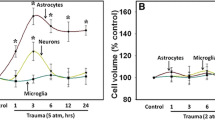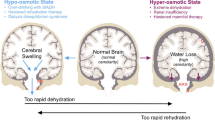Abstract
The pathophysiological chain of events occurring during cerebral ischemia is still poorly understood on a molecular level. Therefore, an in vitro model to study glial swelling mechanisms, using C6 glial cells under controlled extracellular conditions, has been established. Flow cytometry serves to determine even small cell volume changes. In this report, the effects of anoxia and acidosis on glial swelling are summarized. Anoxia alone, or in combination with iodoacetate to inhibit anaerobic glycolysis, did not cause an increase of glial volume for up to 2 h. Acidification of the incubation medium below pH 6.8, on the other hand, was immediately followed by cell swelling to 115% of normal. Amiloride or the absence of bicarbonate and Na+ in the medium significantly reduced glial swelling. The data support the contention that swelling results from an activation of the Na+/H+-antiporter to control intracellular pH. It is suggested that swelling in an ischemic penumbra is promoted by this mechanism. Therapeutic approaches to control cerebral pH might be useful to protect brain tissue in cerebral ischemia.
Similar content being viewed by others
References
Ames A. and Nesbett F. B. (1983a) Pathophysiology of ischemic cell death. I. Time of onset of irreversible damage; Importance of different components of the ischemic insult.Stroke 14, 219–226.
Ames A. and Nesbett F. B. (1983b) Pathophysiology of ischemic cell death. II. Changes in plasma membrane permeability and cell volume.Stroke 14, 227–233.
Arieff A. I. and Kleeman C. R. (1974) Cerebral edema in diabetic comas. II. Effects of hyperosmolality, hyperglycemia and insulin in diabetic rabbits.J. Clin. Endocrinol. Metabol.,38, 1057–1067.
Astrup J., Symon L., Branston N. M., and Lassen N. A. (1977) Cortical evoked potential and extracellular K+ and H+ at critical levels of brain ischemia.Stroke 8, 51–57.
Baethmann A. and Van Harreveld A. (1973) Water and electrolyte distribution in grey matter rendered edematous with a metabolic inhibitor.J. Neuropathol. Exp. Neurol. 32, 408–423.
Baethmann A. and Sohler K. (1975) Electrolyte- and fluid-spaces of rat brain insitu after infusion with dinitrophenol.J. Neurobiol. 6, 73–84.
Baethmann A. (1978) Pathophysiological and pathochemical aspects of cerebral edema.Neurosurg. Res. 1, 85–100.
Baethmann A., Oettinger W., Rothenfusser W., Kempski O., Unterberg A., and Gieger R. (1980) Brain edema factors: Current state with particular reference to plasma constituents and glutamate.Adv. Neurol.,28, 171–195.
Baethmann A., Kempski O., Schneider S., Zimmer M., Neu A., v. Rosen F., and Jansen M. (1985) Normal and abnormal neuronal and glial volume,Brain Insults in Infants and Children (James H. E., Anas N. G., and Perkin R. M., eds.), Grune & Stratton, Orlando; FL, pp. 25–46.
Benda P., Lightbody J., Sato G., Levine L., and Sweet W. (1968) Differentiated rat glial cell strain in tissue culture.Science 161, 370, 371.
Bissell M. G., Rubinstein L. J., Bignami A., and Herman M. M. (1974) Characteristics of the rat C-6 glioma maintained in organ culture systems. Production of glial fibrillary acidic protein in the absence of gliofibrillogenesis.Brain Res. 82, 77–89.
Cala P. M. (1983a) Cell volume regulation by amphiuma red blood cells. The role of Ca++ as a modulator of alkali metal/H+-exchange.J. Gen. Physiol. 82, 761–784.
Cala P. M. (1983b) Volume regulation by red blood cells. Mechanisms of ion transport.Molec. Physiol. 4, 33–52.
Chaussy L., Baethmann A., and Lubitz W. (1981) Electrical sizing of nerve and glia cells in the study of cell volume regulation,Cerebral Microcirculation and Metabolism (Cervos-Navarro J. and Fritschka E., eds.), Raven, New York, NY, pp. 29–40.
Cornog J. L., Gonatas N. K., and Feierman J. R. (1967) Effects of intracerebral injection of ouabain on the fine structure of rat cerebral cortex.Am. J. Pathol. 51, 572–590.
Fisher R. S., Persson B.-E., and Spring K. R. (1981) Epithelial cell volume regulation: Bicarbonate dependence.Science 214, 1357–1359.
Go K. G. (1986) Disturbances of extracellular homeostasis after a primary insult as a mechanism in secondary brain damage,Mechanisms of Secondary Brain Damage (Baethmann A., Go K. G., and Unterberg A., eds.), Plenum, New York, NY, pp. 127–138.
Grinstein S., Clarke C. A., Dupre A., and Rothstein A. (1982) Volume-induced increase of anion permeability in human lymphocytes.J. Gen. Physiol. 80, 801–823.
Grinstein S., Cohen S., and Rothstein A. (1984) Cytoplasmic pH regulation in thymic lymphocytes by an amiloride-sensitive Na+/H+-antiport.J. Gen. Physiol. 83, 341–369.
Grinstein S., Cohen S., Goetz J. D., and Rothstein A. (1985) Na+/H+-exchange in volume regulation and cytoplasmic pH homeostasis in lymphocytes.Fed. Proc. 44, 2508–2512.
Grinstein A. and Rothstein A. (1986) Mechanisms of regulation of the Na+/H+-exchanger.J. Membrane Biol. 90, 1–12.
Hoffmann E. K. and Hendil K. B. (1976) The role of amino acids and taurine in isoosmotic intracellular regulation in Ehrlich ascites mouse tumor cells.J. Comp. Physiol. 108, 279–286.
Kachel V. (1976) Basic principles of electrical sizing of cells and particles and their realization in the new instrument “Metricell”.J. Histochem. Cytochem. 24, 211–230.
Kempski O. (1982a) Die Lokalisation des Glutamat-induzierten Hirnödems.Thesis, Ludwig-Maximilians University, Munich, West Germany.
Kempski O., Gross U., and Baethmann, A. (1982b) An in vitro model of cytotoxic brain edema: Cell volume and metabolism of cultivated glial- and nerve-cells.Adv. Neurosurg. 10, 254–258.
Kempski O., Chaussy L., and Gross U., Zimmer M., and Baethmann A. (1983) Volume regulation and metabolism of suspended C6 glioma cells: An in vitro model to study cytotoxic brain edema.Brain Res. 279, 217–228.
Kempski O. (1986a) Cell swelling mechanisms in brain,Mechanisms of Secondary mechanisms causing ischemic cell swelling in vitro, Pharmacology of Cerebral Ischemia (Krieglstein J., ed.), Elsevier, Amsterdam, pp. 131–139.
Kempski O., Zimmer M., Neu A., v. Rosen F., Jansen M., and Baethmann A. (1987) Control of glial cell volume in anoxia. In vitro studies on ischemic cell swelling.Stroke 18, 623–628.
Kempski O., Staub F., Jansen M., Schödel F., and Baethmann A. (1988) Glial swelling during extracellular acidosis in vitro.Stroke 19, 385–392.
Krane E. J., Rockoff M. A., Wallman J. K., and Wolfsdorf J. E. (1985) Subclinical brain swelling in children during treatment of diabetic ketoacidosis.N. Engl. J. Med. 312, 1147–1151.
Kregenow F. M. (1971) The response of duck erythrocytes to nonhemolytic hypotonic media: Evidence for a volume controlling mechanism.J. Gen. Physiol. 58, 372–395.
Labourdette G. and Mandel P. (1978) S-100 protein in monolayer cultures of glial cells: Basal level in primary and secondary cultures.Biochem. Biophys. Res. Comm. 85, 1307–1313.
Mahnensmith R. L. and Aronson P. S. (1985) The plasma membrane sodiumhydrogen exchanger and its role in physiological and pathophysiological processes.Circ. Res. 56, 773–788.
Negendank W. and Shaller C. (1982) The effects of temperature and ouabain on steady-state Na and K exchanges in human lymphocytes.J. Cell Physiol. 113, 440–454.
Nicklas W. J. and Browning E. T. (1983) Glutamate uptake and metabolism in C-6 glioma cells: Alterations by potassium ion and dibutyryl cAMP.J. Neurochem. 41, 179–187.
Pappius H. M. (1979) Evolution of edema in experimental cerebral infarction,Cerebrovascular Diseases (Price T. R. and Nelson E., eds.), Raven, New York, NY, pp. 131–139.
Pfeiffer S. E., Betschart B., Cook J., Mancini P., and Morris R. (1977) Glial cell lines,Cell Tissue, and Organ Cultures in Neurobiology (Fedoroff S., Hertz L., eds.), Academic, New York, NY, pp. 287–346.
Pitts R. F., Ayer J. L. and Schiess W. A. (1949) The renal regulation of acid base balance in man. III. The reabsorption and excretion of bicarbonate.J. Clin. Invest. 28, 35–44.
Rothenfusser W. (1982) Die Bedeutung von Glutamat als Hirnödemfaktor.Thesis, Ludwig-Maximilians University, Munich, Federal Republic of Germany.
Sapirstein V. S. and Benos D. J. (1984) Activation of amiloride-sensitive sodium transport in C6 glioma cells.J. Neurochem. 43, 1098–1105.
Siesjö B. K. (1985) Acid-base homeostasis in the brain: physiology, chemistry, and neurochemical pathology,Molecular Mechanisms of Ischemic Brain Damage (Kogure K., Hossmann K.-A., Siesjö B. K. and Welsh F. A., eds.), Elsevier, Amsterdam,Progr. Brain. Res. 63, 121–154.
Tasaki I. and Iwasa K. (1980) Swelling of nerve fibers during action potentials.Upsala J. Med. Sci. 85, 211–215.
Tasaki I., Nakaye T., and Byrne P. M. (1985) Rapid swelling of neurons during synaptic transmission in the bullfrog sympathetic ganglion.Brain Res. 331, 363–365.
Unterberg A., Maier-Hauff K., Dautermann C., Hack U., Schürer L., and Baethmann A. (1986) Role of mediator compounds in secondary brain damage—current evidence,Mechanisms of Secondary Brain Damage (Baethmann A., Go K. G., and Unterberg A., eds.), Plenum, New York, NY, pp. 139–150.
Van Harreveld A. (1982) The extracellular space in the vertebrate central nervous system,The Structure and Function of Nervous Tissue (Bourne G. H., ed.), Academic, New York, NY, pp. 447–511.
Van Harreveld A. and Fifkova E. (1974) Involvement of glutamate in memory formation.Brain Res. 81, 455–467.
Van Harreveld A. and Fifkova E. (1975) Swelling of dendritic spines in the fascia dentata after stimulation of the perforant fibers as a mechanism of post-tetanic potentiation.Exp. Neurol. 49, 736–749.
Zimmer M., Kempski O., Neu A., v. Rosen F., and Baethmann A. (1984) Anoxic incubation of suspended glial cells. An in-vitro model of cerebral anoxia to study cytotoxic brain edema.Adv. Neurosurg. 12, 271–273.
Author information
Authors and Affiliations
Additional information
Supported by Deutsche Forschungsgemeinschaft: Ba 452/6-6
Rights and permissions
About this article
Cite this article
Kempski, O., Staub, F., Rosen, F.V. et al. Molecular mechanisms of glial swelling in vitro. Neurochemical Pathology 9, 109–125 (1988). https://doi.org/10.1007/BF03160357
Received:
Accepted:
Issue Date:
DOI: https://doi.org/10.1007/BF03160357




